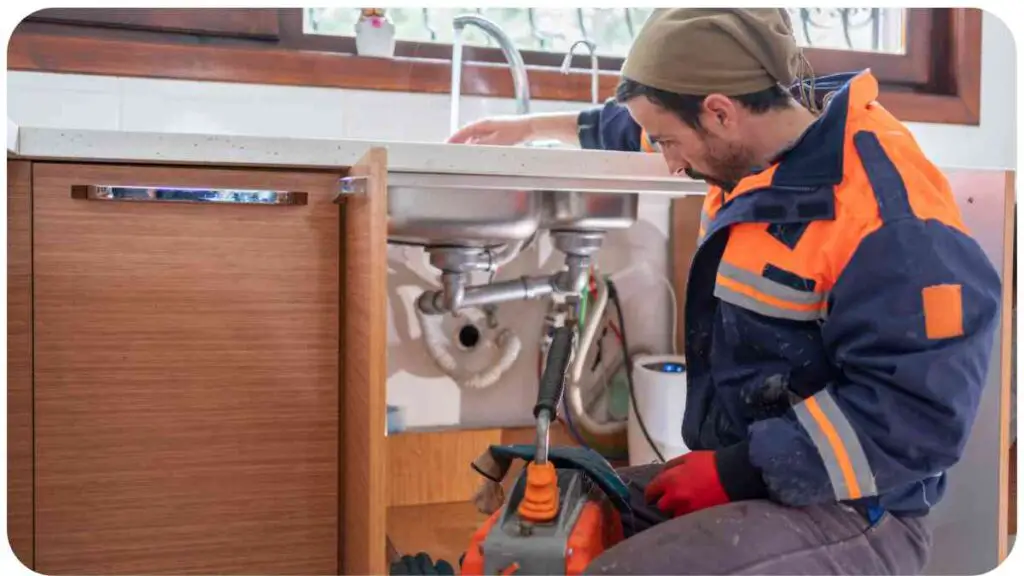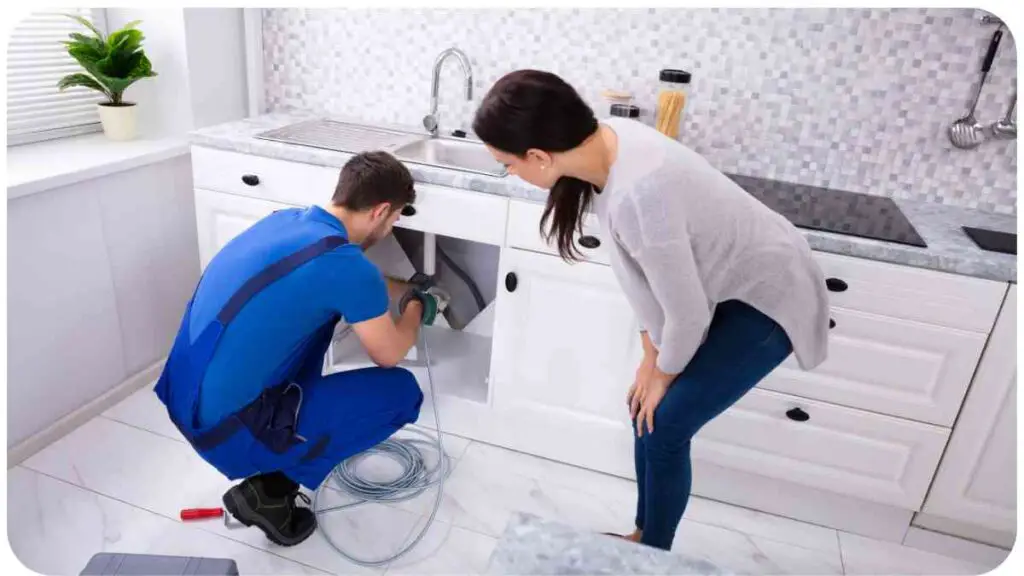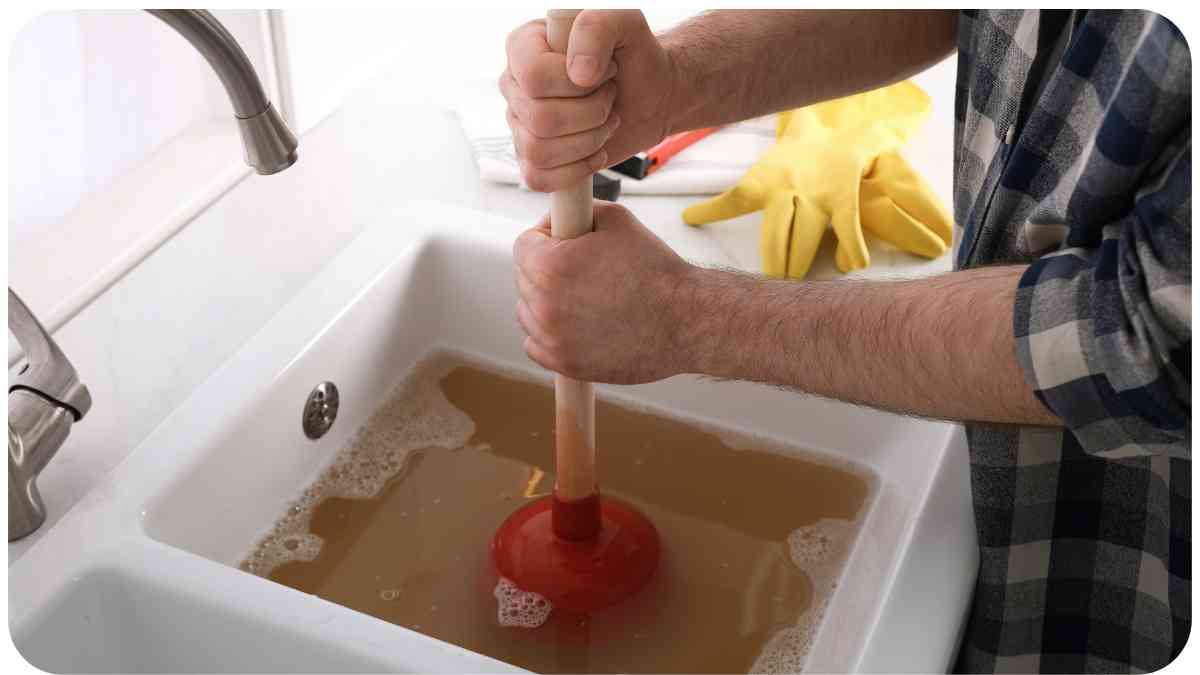Is your sink taking an eternity to drain? Slow-draining sinks are a common household nuisance that can disrupt daily routines and cause inconvenience. Understanding the root causes and implementing the right solutions can help you fix this issue promptly. In this comprehensive guide, we will explore the reasons behind slow drainage, provide DIY remedies, discuss when to seek professional assistance, and offer preventive measures to maintain optimal sink health. So, let’s dive in and get your sink back to smooth operation!
| Takeaway |
|---|
| Regular maintenance and preventive measures are key to preventing slow draining sinks. |
| Natural remedies like baking soda, vinegar, and hot water can effectively unclog sinks. |
| Quick fixes like using a plunger or wire hanger can provide temporary solutions for minor clogs. |
| Persistent slow drainage issues may require inspections, drain snakes, or professional help. |
| Proper sink maintenance extends the lifespan of your plumbing system and saves money on repairs. |
2. Understanding the Causes of Slow Drainage
Before you jump into tackling the issue, it’s crucial to identify the underlying causes of slow drainage in your sink. Several factors can contribute to this problem, including:
To fix a slow-draining sink, it’s important to address any leaks in the kitchen sink drain. Our article on How to Fix a Leaking Kitchen Sink Drain provides helpful DIY solutions to tackle this common issue.
Table 2.1: Common Causes of Slow Drainage
| Cause | Description |
| Accumulation of debris | A buildup of food particles, grease, or hair can obstruct the flow of water through the drain. |
| Clogged P-trap | The P-shaped pipe beneath your sink can get clogged with waste, causing water to drain slowly. |
| Mineral deposits | Hard water can leave mineral deposits in pipes over time, reducing the pipe diameter and flow rate. |
| Tree root intrusion | In some cases, tree roots can infiltrate underground pipes, disrupting water flow and causing clogs. |
| Faulty venting | Inadequate venting can create a vacuum effect, impeding the smooth passage of water through the drain. |
| Pipe damage or misalignment | Cracked or misaligned pipes can restrict water flow and lead to slow drainage issues. |
| Structural issues within the plumbing system | Faulty installation or design flaws may hinder water flow, resulting in slow drainage. |
Understanding these causes is the first step toward effectively resolving your slow-draining sink problem.
3. Common DIY Solutions for Slow Draining Sinks

In many cases, slow-draining sinks can be addressed using simple do-it-yourself (DIY) remedies. By utilizing some household items and a bit of elbow grease, you can often restore the smooth flow of water in no time. Here are a few effective DIY solutions to try:
Table 3.1: DIY Solutions for Slow Draining Sinks
| Solution | Description |
| Boiling water | Pouring boiling water down the drain can help dissolve soap scum, grease, and small blockages. |
| Baking soda and vinegar | This natural combination creates a foaming reaction, which can break down gunk and improve water flow. |
| Plunger | Using a plunger can help dislodge clogs and restore proper drainage. |
| Drain snake | A drain snake, also known as a plumbing auger, can assist in removing stubborn debris or hair obstructing the drain. |
| DIY enzyme cleaner | Enzyme-based cleaners can eat away at organic matter, effectively clearing the drain blockages. |
| Hot water and salt | A mixture of hot water and salt can help dissolve greasy buildup and enhance drainage. |
By employing these DIY solutions, you can often resolve minor clogs and improve the drainage of your sink.
Keep your kitchen drain free from grease buildup to ensure optimal sink drainage. Learn effective techniques by reading our guide on Cleaning Your Kitchen Drain – No More Grease Buildup.
4. When to Call a Professional Plumber
While DIY solutions can be effective for minor clogs, there are instances when it is best to seek the assistance of a professional plumber. Here are some signs that indicate it’s time to call in the experts:
Table 4.1: Signs that Require Professional Plumbing Help
| Sign | Description |
| Recurring or persistent clogs | If your sink frequently experiences clogs that keep coming back despite your DIY efforts, it’s time to consult a pro. |
| Foul odor or sewage smell | A foul smell emanating from your sink can indicate a more significant plumbing issue that needs professional attention. |
| Slow drainage in multiple sinks | If multiple sinks in your household are draining slowly, it could be a sign of a larger plumbing problem. |
| Gurgling sounds or unusual noises | Strange noises while water is draining can signify a blockage or an issue with the plumbing system. |
| Water backup or overflow | Any signs of water backup or overflow indicate a severe problem that requires immediate professional intervention. |
| Limited or no plumbing knowledge | If you’re unsure about your plumbing skills or lack the necessary tools, it’s best to leave the job to the experts. |
Remember, professional plumbers possess the experience, tools, and expertise needed to diagnose and resolve complex plumbing issues effectively.
5. Preventive Measures to Maintain a Healthy Sink

Prevention is always better than cure! By practicing good habits and implementing some preventive measures, you can reduce the likelihood of experiencing slow drainage issues in the future. Here are some tips to maintain a healthy sink:
Is your sink experiencing drainage issues due to your washing machine? Find out how to resolve this problem in our step-by-step guide: Washing Machine Draining Into Your Sink? Here’s How to Fix It.
Table 5.1: Preventive Measures for a Healthy Sink
| Tip | Description |
| Avoid disposing of grease or oil | Pouring grease down the drain is a common cause of clogs. Instead, dispose of it in a container and throw it in the trash. |
| Use drain covers or strainers | Installing drain covers or strainers can catch debris and prevent it from entering the drain, reducing the occurrence of clogs. |
| Regularly clean your drains | Routinely flushing your drains with hot water can help prevent the buildup of debris and keep your sink flowing smoothly. |
| Watch what you put in the sink | Be mindful of what goes down your drain. Avoid flushing large food scraps, coffee grounds, or non-biodegradable items. |
| Use enzyme cleaners periodically | Enzyme-based cleaners can be used regularly to keep your pipes clean and free from organic matter buildup. |
| Schedule routine plumbing inspections | Regular maintenance by a professional plumber can help identify and address any plumbing issues before they become major problems. |
By incorporating these preventive measures into your daily routine, you can significantly reduce the likelihood of encountering a slow-draining sink.
6. How to Unclog a Kitchen Sink – Step-by-Step Guide
A clogged kitchen sink can be a major inconvenience, disrupting your daily activities. Here’s a step-by-step guide to help you unclog your kitchen sink:
When it comes to sink drainage, considering hot water solutions can be beneficial. Explore our article on Maximize Your Bath Time: Hot Water Solutions to discover ways to optimize your sink drainage using hot water.
Table 6.1: Unclogging a Kitchen Sink – Step-by-Step
| Step | Description |
| Step 1: Remove standing water | If there is standing water in the sink, use a bucket or a cup to remove as much water as possible before proceeding. |
| Step 2: Boil water | Boil a large pot of water, preferably a kettle, and let it cool for a couple of minutes. |
| Step 3: Pour baking soda | Measure half a cup of baking soda and pour it down the drain. |
| Step 4: Add vinegar | Follow the baking soda with one cup of vinegar. You will observe a foaming reaction. |
| Step 5: Cover and wait | Cover the drain with a stopper, piece of cloth, or any appropriate cover and wait for about 15-30 minutes. |
| Step 6: Boil water again | After the waiting period, boil another kettle of water and pour it down the drain to flush away the loosened debris. |
| Step 7: Test the drain | Turn on the faucet and check if the water is draining freely. Repeat the process if needed. |
| Step 8: Clean the P-trap | If the clog persists, locate the P-trap under the sink and place a bucket beneath it. Unscrew the trap and clean it. |
| Step 9: Reassemble and test | Reassemble the P-trap and turn on the water to ensure proper drainage. |
| Step 10: Dispose of debris | Properly dispose of the debris collected during the unclogging process. |
By following these steps, you can often unclog a kitchen sink without the need for professional assistance.
7. How to Unclog a Bathroom Sink – Step-by-Step Guide
A slow-draining bathroom sink can disrupt your daily routine. To unclog a bathroom sink effectively, follow this step-by-step guide:
Table 7.1: Unclogging a Bathroom Sink – Step-by-Step
| Step | Description |
| Step 1: Clear the sink area | Remove any objects or debris surrounding the sink to create ample working space. |
| Step 2: Protect the drain | Place a cloth or rag over the drain to prevent any debris from falling into it during the unclogging process. |
| Step 3: Remove the stopper | Depending on the type of stopper your sink has, carefully unscrew, lift, or detach it from the drain. |
| Step 4: Use a plunger | Position the plunger over the drain, ensuring a tight seal, and begin plunging vigorously for about a minute. |
| Step 5: Boiling water | Boil a kettle of water and carefully pour it down the drain in intervals, allowing the water to work on the clog. |
| Step 6: Utilize a drain snake | If the plunging and boiling water don’t resolve the clog, use a drain snake to dislodge any stubborn debris. |
| Step 7: Rinse with hot water | Flush the drain with hot water to remove any remaining particles and check if the water flows freely. |
| Step 8: Reassemble and test | Once the clog is cleared, reattach the stopper and test the drain by running water to ensure proper drainage. |
| Step 9: Clean and maintain | Regularly clean and maintain your bathroom sink to prevent future clogs by implementing preventive measures. |
By following these steps, you can regain a fully functional bathroom sink and enjoy a smooth drainage system.
8. Clearing a Slow Draining Sink with Natural Remedies
If you prefer using natural remedies to unclog your sink, here are some effective options to consider:
Table 8.1: Natural Remedies for Clearing a Slow Draining Sink
| Remedy | Description |
| Salt and baking soda | Mix equal parts of salt and baking soda, and pour the mixture down the drain. Follow with boiling water to break down the clog. |
| Vinegar and salt | Combine vinegar and salt to create a paste. Apply the paste to the drain area and let it sit for 15 minutes before rinsing with water. |
| Baking soda and lemon juice | Sprinkle baking soda into the sink drain, followed by lemon juice. Let the mixture sit for a while before rinsing with hot water. |
| Salt and cream of tartar | Mix equal parts of salt and cream of tartar, pour down the drain, and allow it to sit for half an hour. Rinse with hot water. |
| Hot water and dish soap | Pour a generous amount of dish soap down the drain, followed by hot water. Let it sit for a few minutes before flushing with water. |
| Coke or Pepsi | Pour a can of Coke or Pepsi down the clogged drain and let it sit for an hour. Follow with hot water to flush away the debris. |
These natural remedies can prove effective in resolving minor clogs, promoting eco-friendly solutions for your plumbing needs.
9. Quick Fixes for Minor Sink Drainage Issues
In some cases, you may encounter minor sink drainage issues that can be resolved with quick fixes. Here are a few suggestions:
Table 9.1: Quick Fixes for Minor Sink Drainage Issues
| Quick Fix | Description |
| Boiling water | Simply pouring boiling water down the drain can often dislodge minor clogs and improve drainage. |
| Plunger | Use a plunger to create pressure and dislodge any obstructions in the drain. |
| Wire hanger | Straighten a wire hanger and create a small hook at one end to remove debris stuck in the drain. |
| Dish soap and hot water | Pour a generous amount of dish soap down the drain, followed by hot water, to break down grease. |
| Wet and dry vacuum | Use a wet and dry vacuum to suck out debris from the sink drain. |
When faced with minor issues, these quick fixes can save you time and effort, ensuring your sink drains smoothly.
10. Addressing Persistent Slow Drainage Problems
If you’re dealing with persistent slow drainage in your sink, it’s essential to take more thorough measures to address the issue. Here are some steps to consider:
Table 10.1: Addressing Persistent Slow Drainage Problems
| Step | Description |
| Inspect the P-trap | Check the P-trap under your sink for any clogs or debris. Clean the trap or replace it if necessary. |
| Use a plumbing snake | Insert a plumbing snake into the drain and twist or push it through to dislodge and remove any stubborn blockages. |
| Consider using a drain auger | If a plumbing snake isn’t sufficient, a drain auger is a longer and more robust tool to penetrate and clear the clog. |
| Apply a commercial drain cleaner cautiously | Commercial drain cleaners can be effective, but be cautious and follow the instructions carefully to avoid damage. |
| Call a professional plumber | If all DIY efforts fail, it’s best to contact a professional plumber who can diagnose and address the issue correctly. |
By following these steps, you can tackle persistent slow drainage problems effectively and ensure a fully functional sink.
11. Essential Tools for Unclogging Sinks
Having the right tools on hand is crucial when it comes to unclogging sinks. Here is a list of essential tools you might need:
Table 11.1: Essential Tools for Unclogging Sinks
| Tool | Description |
| Plunger | A must-have tool for dislodging and clearing minor clogs. |
| Drain snake | Also known as a plumbing auger, it helps reach and remove stubborn blockages deep within the pipes. |
| Drain auger | A longer, more robust tool designed to handle tougher clogs and reach greater depths within the plumbing system. |
| Pliers | Useful for unscrewing and disconnecting the P-trap or other plumbing components for cleaning or replacement. |
| Bucket or container | Used to catch water or debris when disassembling plumbing components. |
| Wrench | Helps to loosen or tighten nuts and bolts during plumbing repairs. |
| Gloves | Protects your hands from debris, dirty water, and potential hazards while working on your sink. |
| Safety goggles | Provides eye protection from splashes, chemical cleaners, or debris. |
| Wire hanger or bent wire | A makeshift tool that can be used to snag and remove debris from the drain. |
Having these essential tools readily available will assist you in addressing any sink clogging issues effectively.
12. Importance of Regular Sink Maintenance
Regular sink maintenance is vital for keeping your plumbing system in good condition and preventing clogs and other issues. Here are some reasons why regular sink maintenance is important:
Table 12.1: Importance of Regular Sink Maintenance
| Reason | Description |
| Prevents clogs | Regular maintenance helps keep your sink free from debris and buildup, reducing the risk of clogs and slow drains. |
| Extends the lifespan of your plumbing | By keeping your sink and pipes clean and well-maintained, you can prolong the life of your plumbing system. |
| Saves money on repairs | Proactive maintenance can help detect minor issues before they become major problems, saving you from costly repairs. |
| Promotes better hygiene | Regular cleaning and maintenance help prevent bacteria growth and ensure a clean and hygienic sink. |
| Preserves water efficiency | Proper maintenance can prevent leaks and drips, maximizing water efficiency and reducing water wastage. |
| Enhances the overall functionality of your sink | A well-maintained sink operates smoothly, allowing for convenient and hassle-free daily use. |
By incorporating regular sink maintenance into your routine, you can avoid common plumbing problems and enjoy a well-functioning sink for years to come.
13. Conclusion
Maintaining a healthy sink and addressing slow drainage issues can be achieved through proper maintenance, occasional DIY techniques, and knowing when to seek professional help.
By implementing preventive measures, unclogging your sink using natural remedies or quick fixes, and addressing persistent problems with the right tools and techniques, you can ensure optimal sink functionality and a smoothly flowing drainage system.
Remember, regular maintenance goes a long way in preventing clogs, extending the lifespan of your plumbing, and saving you from costly repairs.
Further Reading
Here are some additional resources for further reading on fixing a slow draining sink:
- 4 Tips to Fix a Slow Draining Sink: This blog post provides four helpful tips to fix a slow draining sink, including using baking soda and vinegar, checking the P-trap, and more.
- How to Unclog a Sink Draining Slow: This article by USA Today covers various methods to unclog a sink draining slowly, such as using a plunger, baking soda, and hot water.
- Genius Tips for Fixing a Slow Draining Sink: House Digest provides genius tips to fix a slow draining sink, including natural remedies, using a drain snake, and advice on preventive maintenance.
These resources offer additional insights and tips to help you effectively tackle the issue of a slow draining sink.
FAQs
How do I know if my sink is draining slowly?
If the water takes longer than usual to drain or you notice water pooling in the sink, it indicates that your sink is draining slowly.
What causes a sink to drain slowly?
Several factors can cause a sink to drain slowly, including buildup of hair, soap scum, food particles, mineral deposits, or a blockage in the drain pipe.
Can I use chemicals to unclog a slow draining sink?
Chemical drain cleaners can be used but should be used cautiously and following the instructions. They may have potential risks and should be avoided if the sink is connected to a septic system.
How can I unclog a sink without using chemicals?
There are several natural methods to unclog a sink without chemicals, like using a plunger, baking soda and vinegar, or a drain snake to dislodge and remove clogs.
When should I call a professional plumber?
You should call a professional plumber if DIY methods fail to resolve the slow draining issue, or if you suspect a more significant underlying plumbing problem that requires expertise to diagnose and fix.
Please note that this information is provided as a general guide, and it’s always recommended to consult professional advice for your specific situation.

Hellen James is the author of the blog and a licensed plumber with over 15 years of experience. She shares her knowledge and experience in plumbing and drainage through insightful and informative articles

